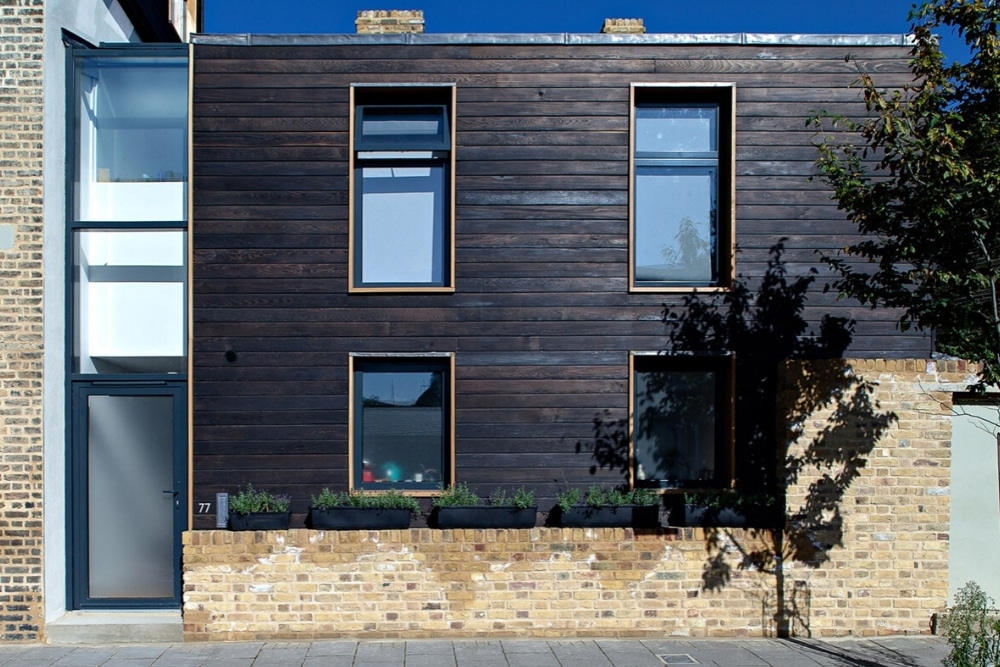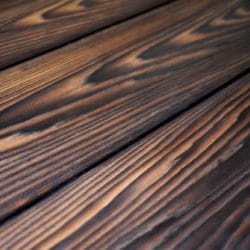For the past century, the European tradition of using wood as a building material has been overshadowed by brick and concrete construction.
With architecture now focused on visual aesthetics and environmental sustainability, designers are shifting focus back to timber cladding. This was clearly illustrated in the high number timber-clad winning entries in this year’s Homebuilding and Renovation Awards.
Yakisugi; the Tradition of Charring Timber
Yakisugi, the tradition of charring timber was developed as a wood preservation technique. The Japanese discovered that by creating a deep, controlled burn on the surface of Japanese Cedar panels, they could increase its durability.
The striking dark finish of charred timber cladding is taking centre stage in contemporary design. It is now seeing a resurgence across the globe.
Exterior Solutions Ltd has a dedicated team who have learnt the art of Yakisugi. We supply our range of Shou Sugi Ban® to developers and architects in the UK. Here we identify the main benefits of charred timber cladding.
Weatherproofing Timber Through the Charring Process

Timber is organic and with over 5000 varieties of timber in the world, there is an extensive choice of grains. It can be cut and shaped with relative ease and is naturally strong and durable. It is, however, a hygroscopic material. This means it expands and contracts in response to changing moisture levels. If exposed to the changing seasons of Europe or Japan, it can crack, buckle and rot.
In Europe, we typically apply oils, varnishes, paints and other protective coatings to the wood. This creates an outer barrier that helps to protect the timber from changing moisture levels. These are highly effective but need to be reapplied on a regular basis in order to maintain weatherproofing.
In Japan, they chose to char in place of applying a coating. The controlled burning of the wood draws out natural resins and leaves a layer of carbon on the surface. As an integral part of the timber, this weatherproofing system is long-lasting. It is often coated with an oil finish for added resilience.
Charred Timber Repels Insects
Another cause of deterioration of timber comes from biological sources including insects, mould and fungi.
We have all seen examples of wooden beams with holes created by wood burrowing beetles (more commonly referred to as woodworm). There is a range of coatings which can be applied to timbers which greatly reduce the risk of infestations. These, however, are not needed on charred wood as the carbon outer layer is a deterrent to insects.
Mould and fungi need very specific moisture and oxygen levels to grow. Techniques such as kiln drying timber, applying protective coatings or charring minimise the risk that these conditions will occur.
Charred Timber has Greater Fire Resistance
It seems contrary, but the process of charring timber increases its resilience to burning. This is achieved because the controlled process removes the soft outer cells, which are quick to ignite. It leaves the tough, lignin cells, which require considerably higher temperatures in order to catch alight.
As such, charred timber has different thermodynamic conductivity to untreated timber. This does not, however, conform to building regulations, so we can add extra fire retardant treatment if required.
Added Strength with Yakisugi

Another surprising benefit is that charring timber adds to its strength. It would be instinctive to believe that removing an outer layer would weaken the wood. Instead, the process draws moisture out and the result is a stronger end product.
The Aesthetic Appeal of Charred Timber
Finally, the finished effect of charred timber has a strong visual impact. By varying the brushing and finishing process, the Japanese achieved a range of effects on cedar. These included a smooth, brushed look and a deep crackled appearance.
A contemporary twist on this traditional technique has opened up a range of other possibilities. In trying Yakisugi on a range of different species, it has been possible to understand and embellish the properties of each timber.
Our Shou Sugi Ban® range includes Douglas Firs. When charred, this creates a strong definition between the wood and grain. It can be infilled with any RAL colour to create striking effects to suit bold exterior and interior design. Charred Larch and Accoya also deliver strong grain patterns for a unique and beautiful finish.
If you prefer a more traditional look, cedar timbers can be charred and either left with a crackled charred finish, lightly brushed for a smooth finish or receive a grain defining heavy brush.
Yakisugi in Summary
Charred timber has been used to spectacular effect in historic and contemporary buildings. We’ve seen a growing demand for both interior and exterior application, but this is more than a passing trend. The heritage process produces a sustainable, durable and beautiful construction material. It looks impressive and preserves the timber.



